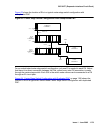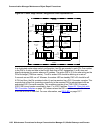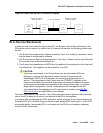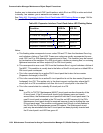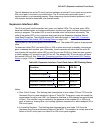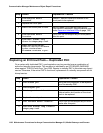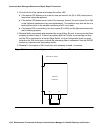
EXP-INTF (Expansion Interface Circuit Pack)
Issue 1 June 2005 1187
The symptoms of the problem in which an invalid system clock causes an Expansion Link to go
down are as follows:
● If the Tone-Clock in the PN provides the current on-line synchronization reference (see
status synchronization), is providing an invalid system clock:
Any EI or SNI circuit pack has a Fiber Out-of-Frame condition or a No Neighbor condition.
An EI circuit pack amber LED blinks quickly when a Fiber Out-of-Frame condition exists (0.1
seconds on, 0.1 seconds off) and Test #238 fails on the EI circuit pack that is out-of-frame.
An SNI circuit pack with a Fiber Out-of-Frame condition blinks its amber LED quickly (0.1
seconds on, 0.1 seconds off) and Test #989 fails on the SNI circuit pack that is out-of-frame.
An EI circuit pack amber LED blinks slowly when a No Neighbor condition exists (0.5
seconds on, 0.5 seconds off) and Test #237 fails on this EI circuit pack, but Test #238
passes.
An SNI circuit pack with a no neighbor condition blinks its amber LED slowly (0.5 seconds
on, 0.5 seconds off) and Test #759 fails on this SNI circuit pack, but Test #989 passes.
● If a Tone-Clock in a PN that does not provide the current on-line synchronization reference
(see status synchronization) is providing an invalid system clock:
In a direct connect configuration, the PN EI circuit pack amber LED will blink quickly (Fiber
Out-of-Frame condition – 0.1 seconds on, 0.1 seconds off).
Test #238 fails on this EI circuit pack.
In a CSS configuration, the SNI connected to the PN EI circuit pack blinks its amber LED
quickly (Fiber Out-of-Frame condition – 0.1 seconds on, 0.1 seconds off).
The PN EI circuit pack amber LED blinks slowly (In-frame, No Neighbor condition – 0.5
seconds on, 0.5 seconds off).
If the PN is in service, Test #237 fails on this EI circuit pack, but Test #238 passes.
These symptoms can also be the result of other problems (for example, one half of the fiber
being unable to transmit data). If the system exhibits these symptoms, execute the following
procedure:
1. Verify that the PN stays down for at least 1 minute.
If the EAL comes back in service after a short time, without switching the active Tone-Clock,
the problem was probably that the on-line synchronization source became invalid (See
SYNC Maintenance documentation for more information).
However, if the EAL(s) have not come back into service after a minute, the synchronization
source is not the cause of the problem. Proceed to step 2.
2. Check for errors via display errors with the Category field set to tone and the Active
Alarms field set to n. Some of the alarms on PN objects might have been resolved if the PN
went down. Refer to the appropriate MO Maintenance documentation for descriptions of
any of the errors occurring at about the same time as the EXP-PN errors, SYS-LINK errors
against EAL s, RNLs, or LNLs, or FIBER-LK (769, 1025, or 1281) errors. Resolve any active
alarms. Also, if Error Type 18 was logged against the SYNC MO when the PN went down,



